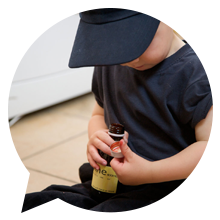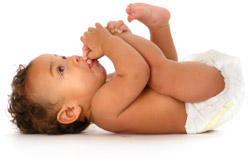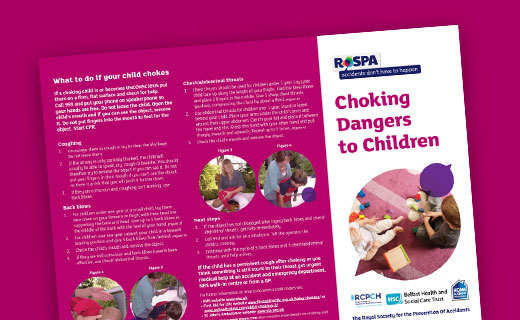How Many Babies Die Each Year From Falling
Accidents to children

Under-5s are particularly at risk of existence injured in home accidents, with falls accounting for the majority of non-fatal accidents and threats to breathing such as suffocation, strangulation and choking causing the highest number of deaths.
Almost home accidents are preventable through increased awareness, improvements in the domicile environment and greater product safe.
Please click on the topic which interests you:

Peak chart
Helping your kid to avoid accidents at home

Safe at home: tips for under-5s
Simple steps you lot can take to help make certain your children are safe
What injuries occur?
The most severe injuries are associated with heat-related accidents and falls from a height. Older children are more likely to sustain fractures than younger counterparts.3 Younger children have a higher percentage of burns and scalds every bit well as poisoning and ingestion accidents.3
Where practice accidents happen?
The largest number of accidents happen in the living/dining room.3 However, the most serious accidents happen in the kitchen and on the stairs. Every year more 67,000 children experience an accident in the kitchen - 43,000 of these are aged between 0-4 years; 58,000 children have accidents on the stairs.3
When practise accidents happen?
- Most happen between late afternoon and early evening, in the summer, during school holidays and at weekends
- Factors such as stress, expiry in the family unit, chronic affliction, homelessness or moving home increment the likelihood of the child having an accident
- Some happen when the usual routine is changed or when people are in a hurry
- Distractions and inadequate supervision are ofttimes the cause of accidents
- Poor housing and overcrowded conditions lead to increased numbers of accidents
- Some accidents are caused by lack of familiarity with surroundings, for example, when visiting friends or relatives, or in holiday adaptation.
Cost of children's accidents
It is hard to give a truthful price of treating children's accidents every bit outpatients and inpatients but in the past it has been estimated at more than £275 million a year. It can cost every bit much as £250,000 to treat ane severe bath water scald. eleven
This figure does not reverberate the long-term costs of prolonged treatment and rehabilitation or the price of pain suffering to the patient. Nor does it reflect the lifetime disfigurement or inability and the financial loss to the patient and family unit or work hours lost caring for an injured kid.
Who is at risk?
- 0-iv-yr-olds accept the near accidents at dwelling.3
- Boys are more likely to have accidents than girls. three
Childhood injuries are closely linked with social deprivation. Children from poorer backgrounds are 5 times more likely to die as a outcome of an blow than children from ameliorate off families - and the gap is widening. 1
Why do children take accidents?
Because children are often absorbed in their own firsthand interests they tin can exist oblivious to their surroundings. They only have a limited perception of the environment because of their lack of experience or development. They are not aware of the consequences of the many new situations that they encounter daily.
Pocket-sized stature
This may forbid a child from seeing in a higher place an obstacle or being seen by an developed.
Inquisitiveness
Curiosity and a spirit of adventure may atomic number 82 a child into danger.
Bravado and horseplay
Boys are especially prone to showing off and over reaching their abilities, especially among friends. Many accidents are caused by horseplay involving pushing, shoving and wrestling.
Stress
Tensions at home and emotional upsets caused past temper, jealousy and over excitement may cause a child to run blindly into danger. Such activity may even be deliberate to seek attention.
Inexperience
A child's interpretation of a situation may exist inaccurate and adults looking afterward small children should exist aware non to expect too much of them.
Inadequate supervision
Children need constant supervision. Medicines, pills and toxic substances should be locked away and fires and stairs should exist guarded.
Rubber and child evolution
Children differ in their rate of development but the information below is a guide to development stages:
| Historic period | Development | Advice |
|---|---|---|
| 0-6 months | Wriggle and kick, grasp, suck, roll over. | Do non go out on a raised surface. |
| 6mths-1 twelvemonth | Stand, sit, crawl, put things in mouth. | Proceed small objects and unsafe substances out of reach |
| i-2 years | Move about, reach things high up, and find subconscious objects, walk, and climb. | Never leave solitary, place hot drinks out of attain, apply a fireguard and stairgates |
| 2-3 years | Be adventurous, climb higher, pull and twist things, scout and re-create. Be a practiced office model and be watchful. | Identify matches and lighters out of sight and reach. |
| three-4 years | Use grown-upwards things, be helpful, sympathise instructions, exist adventurous, explore, walk downstairs alone. | Continue to be a skillful role model, keep being watchful but start condom grooming. |
| 4-5 years | Play exciting games, can be contained, ride a bike, enjoy stories | They can really plan to do things and carry it out. Rules are very important to them, equally long as everybody keeps to the same ones. They enjoy learning. Go on safety training. |
| 5-8 years | Will be subject to peer pressure and will still forget things. | Withal demand supervision, guidance and back up. |
Preventing accidents to children
"A safe, secure and sustainable environment is a prerequisite for a healthy nation." one
A combination of factors is required:
Surroundings
Improvement in planning and design results in safer homes and leisure areas. Adaptations such as fireguards and safety gates help to make the home environment safer.
Teaching
This involves increasing the awareness of the risk of accidents in a multifariousness of settings and providing information on ways of minimising these risks.
Empowerment
Local consultation and customs involvement can generate a potent sense of commitment and ownership. Blow prevention initiatives, which accept been influenced past the community, are more likely to reflect local need and therefore encourage greater delivery.
Enforcement
There is legislation which relates to kid rubber. These regulations ensure that the products we buy meet a reasonable level of safety operation and that new dwellings meet an acceptable level of safe.
General safety advice
- Children should exist supervised at all times
- Keep floors free of toys and obstructions that can exist tripped over
- Always employ a securely fitted rubber harness in a pram, pushchair or highchair
- Never leave babies unattended on raised surfaces
- Do not place infant bouncers on raised surfaces - they could fall off with the movement of the baby
- The use of infant-walkers and table-mounted high chairs is non recommended.
Falls
Around x children die as a result of falls each year - some from windows and balconies and the remainder generally from stairs. 2,four,ten
Falls are by far the virtually mutual causes of accidents in the home; they account for 44 per cent of all children's accidents. 3
Most falls involve tripping over on the same level. However, the almost serious consequences result from falls between two levels, such as falling out of a pram or highchair or falling from a bed. The worst injuries are sustained when a child falls from a great peak or lands on something hard, abrupt or hot.
Many accidents are caused past horseplay involving pushing, shoving and wrestling. Children have besides died or accept been seriously injured by heavy objects such equally furniture and televisions being pushed or pulled over them. Sets of drawers, in a child'south eyes, make ideal climbing frames but, if unsecured, they pull over easily.
Stairs and windows
Prevention
- Fit a rubber gate BS EN 1930: 2011 5 at the acme and bottom of stairs
- Never leave tripping hazards on the stairs
- Stairs should be carefully maintained - damaged or worn carpet should be repaired or removed
- Make sure balustrades are strong and do not accept whatever footholds for climbing
- Stairs should always be well lit
- Fit child resistant window restrictors but make sure you lot can get out easily in an emergency
- Practise not put annihilation under the window that can exist climbed on
- Article of furniture and tall kitchen apparatus, at risk from being pulled over, should be secured to the wall.
Fires
Domestic fires pose i of the greatest risks to children. Children playing with matches and lighters frequently start business firm fires.
Prevention
- Go along matches and lighters out of sight and attain of children
- Always use a fireguard BS 8423: 2010 and secure it to the wall
- Extinguish and dispose of cigarettes properly
- Have an escape road planned, and exercise it, in instance of fire
- Fit a smoke alarm which complies with BS EN 14604 2005 and check it regularly
- The incidence of burns and scalds in young children is much higher than that of older children and adults. 3
Scalds and burns
Many of the children who become to accident and emergency with a burn or a scald are referred on for further infirmary treatment. Recovery may be long and painful and many are left with permanent scarring.
Hot drinks cause most scalds to children under the age of five. A child's skin is much more sensitive than an developed's and a hot drink can yet scald a kid fifteen minutes subsequently being made. Young children are also very vulnerable to sunburn.
Hot bath water is responsible for the highest number of fatal and astringent scalding injuries among immature children. Around 500 children, mainly under fives, are admitted to infirmary and a farther 2000 attend A&East departments every yr as a result of bath water scalds.
Children tin also endure burns after contact with open fires, a cooker, irons, curling tongs and hair straighteners, cigarettes, matches, cigarette lighters and many other hot surfaces.
Prevention
- Never hold a hot drink and a child at the aforementioned time
- Never leave young children alone in the bath
- Put hot drinks out of accomplish and away from the edges of tables and worktops
- Encourage the use of a coiled flex or a cordless kettle
- Continue pocket-sized children out of the kitchen whenever possible
- Run the domestic hot h2o organisation at 46°C or fit a thermostatic mixing valve to taps
- When running a bath turn the cold h2o on first and always test the water temperature with your elbow before letting a child become into the bath or shower
- Always utilise rear hotplates and turn the panhandles away from the front of the cooker
- Keep hot irons, curling tongs and hair straighteners out of achieve fifty-fifty when cooling down.
Glass-related accidents
The increased use of glass in the dwelling has led to more drinking glass related accidents. Every year children dice following an accident with architectural drinking glass. Many children are likewise injured when glass tumblers and bottles break.
Prevention
- Use safety glass to BS 6206 (laminated, toughened or glass which passes the bear upon examination) in all replacement windows and doors - particularly at low level. Laminated glass is good for condom and security
- Make existing drinking glass safer past applying shatter resistant film
- When buying furniture which incorporates drinking glass, expect for approval to BS EN 12521:2009 and BS 14749-2005, BS EN 14072:2003, BS EN 12150-one:2000 and BS EN 12600-2002
- Ever clear upward broken drinking glass quickly and dispose of it safely
- Buy a greenhouse or cold frame with special safety glazing features or isolate with fencing.
Poisoning
About poisoning accidents involve medicines, household products and cosmetics. Some poisoning agents tin cause breathing difficulties - seek medical attending immediately.
More than than 28,000 children receive handling for poisoning, or suspected poisoning accidents every year. 3
Hither you can find more information on poisoning accidents involving household products.
Prevention
- Keep medicines and chemicals out of sight and reach of children, preferably in a locked cupboard
- Wherever possible, buy products in child resistant containers
- Always store chemicals in their original containers
- Dispose of unwanted medicines and chemicals safely
- Avoid buying plants with poisonous leaves or berries or those that can irritate the skin.

Suffocating and choking
Children tin eat, inhale or asphyxiate on items such as modest toys, peanuts and marbles.
Nappy sacks, used to dispose of soiled nappies, can also pose a risk to babies and immature children. We are enlightened of at to the lowest degree xiv deaths involving these items since 2001, where babies have suffocated after a nappy sack covered their mouth and nose, or have choked after putting a nappy sack in their oral fissure.
Parents and carers are generally aware of the dangers posed by plastic bags, but may not make the link to nappy sacks posing similar risks. Nappy sacks or bags tend to be fragranced, are made of a much more than flimsy material, and do not rustle in the same way equally plastic bags meaning they can be easily grasped and breathed in past young babies without parents realising.
Babies and minor children are nearly at risk from choking because they examine things around them by putting them in their mouths.
Prevention
- Choose toys appropriate to the age of the child
- Ensure that small objects such as marbles and peanuts and small-scale toys are kept out of achieve of children under three years old
- Encourage older children to keep their toys away from their younger playmates
- Pull cords on curtains and blinds should exist kept brusque and kept out of reach
- Keep animals, especially cats, out of the bedroom and use a net on a pram
- Keep nappy sacks out of the reach of babies and immature children
- Never store nappy sacks in or around the cot or pram.
- Pocket-size food such as grapes, cherry tomatoes, blackberries and other soft fruits should cut into quarters to foreclose choking.
- Babe should always sleep on their back with their feet at the human foot of their cot. Tuck the blanket in across their breast and nether their arms and keep the cot free from bumpers, pillows and soft toys.
- Ensure your child is the correct age for the cot, bed or other sleep product y'all wish to use. Kids' 2-in-i (combination) portable airbeds/sleeping numberless, which are frequently promoted for holidays, are not suitable for babies due to the risk of suffocation. Always check the labels and follow the safe instructions.
Farther information on Choking hazards in the home and how to avoid them* tin can be found here. Nappy sack risk awareness materials tin be found on the campaign page.
For more information virtually keeping children condom at bedtime.
*Reproduced with kind permission of the British Association of Paediatric Otorhinolaryngology (BAPO) and British Association of Otorhinolaryngology – Caput & Neck Surgery (BAO-HNS)

Strangulation including blind cords
At to the lowest degree 33 young children across the Great britain accept died because of looped blind cords since 2001 – that'due south one or ii children each year – and there will exist many more virtually misses.. Further information can be found on our blind cords campaign folio.
Drowning
Children can drown in less than 3cm of water. They should exist under abiding supervision when in or virtually whatever water.
Prevention
- Never leave children or babies in the bath unsupervised, even for a moment
- Never leave uncovered bowls or buckets of water around the home
- Paddling pools should be emptied and stored abroad when not in use
- Garden ponds should be filled in while children are small or securely fenced off. Take special care when visiting other people's gardens.
References
- Department OF Health. Our healthier nation: a contract for health. Consultation Newspaper. London: The Stationary Office, 1998.
- Part for National Statistics: Mortality Statistics; injury and poisoning 2002: England & Wales. Serial DH4 no. 27.
- CONSUMER SAFETY UNIT. 24th Almanac Report, Dwelling house Accident Surveillance System. London: Section of Merchandise and Industry, 2002.
- Full general Register Offices for Scotland: Annual Report of the Registrar Full general for Scotland 2002.
- BS EN 1930:2011 Specification for condom requirements for child safe barriers for domestic utilise.
- BS EN 14604 2005 Specification for cocky contained smoke alarms and point-type fume detectors.
- BS EN 12521:2009 Specification for inclusion of glass in the structure of tables or trolleys.
- BS 14749-2005, BS EN 14072:2003, BS EN 12150-1:2000 and BS EN 12600-2002 Specification for inclusion of glass in the construction of piece of furniture other than tables or trolleys, including cabinets, shelving systems and wall hung or free standing mirrors.
- HOGG, C. Preventing children's accidents: a guide for wellness regime and boards . London: Kid Accident Prevention Trust, 1996.
- General Register Office (Northern Republic of ireland): Registrar Full general Annual Report 2002: Section half dozen- Causes of death.
- CAPT (Child Accident Prevention Trust) 18 Farringdon Lane, London EC1R 3HA
RoSPA cannot exist held responsible for the accuracy or completeness of any pages on linked websites.
Source: https://www.rospa.com/home-safety/advice/accidents-to-children
0 Response to "How Many Babies Die Each Year From Falling"
Post a Comment